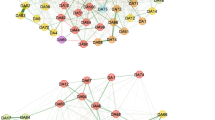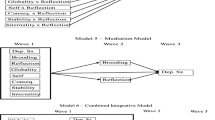Abstract
Positive thoughts play a significant role in the experience and recovery from depression. The Coping Attitudes Scale (CAS) is a rationally derived measure of positive cognitions. The CAS contains statements reflective of coping attitudes along five domains: life perspective, personal accomplishment, positive future, self-worth, and coping with problems. The current study examined the CAS in psychiatric outpatients and college students. Measures of depression, hopelessness, suicidal ideation and positive attitudes were administered to 82 adult psychiatric outpatients and 156 college students. Depression and hopelessness were strongly, negatively, partially correlated with each of the CAS factors, after controlling for age. Relationships among individual CAS factors and suicidal ideation demonstrated weak to moderate partial associations, after controlling for age. Depression was significantly associated with the coping with problems subscale (R 2 = .530). Hopelessness was significantly related to the positive future subscale (R 2 = .696). Further, the CAS demonstrated a significant relationship with depression and hopelessness, even after accounting for the Automatic Thoughts Questionnaire-Revised, Positive subscale. The CAS may be an improved measure of positive attitudes that could be useful in establishing a patient’s baseline of positive thinking, determining targets for therapy, and in monitoring progress in treatment.
Similar content being viewed by others
References
Alford, B. A., Lester, J. M., Patel, R. J., Buchanan, J. P., & Giunta, L. C. (1995). Hopelessness predicts future depressive symptoms: A prospective analysis of cognitive vulnerability and cognitive content specificity. Journal of Clinical Psychology, 51, 331–339.
Alloy, L., Abramson, L., Walshaw, P., & Neeren, A. (2006). Cognitive vulnerability to unipolar and bipolar mood disorders. Journal of Social and Clinical Psychology, 25, 726–754.
Barkham, M., Mullin, T., Leach, C., Stiles, W. B., & Lucock, M. (2007). Stability of the CORE-OM and the BDI-I prior to therapy: Evidence from routine practice. Psychology and Psychotherapy: Theory, Research, and Practice, 80, 269–278.
Beck, A. T., Brown, G., Berchick, R. J., Stewart, B. L., & Steer, R. A. (1990). Relationship between hopelessness and ultimate suicide: A replication with psychiatric outpatients. American Journal of Psychiatry, 142, 190–195.
Beck, A. T., Brown, G. K., & Steer, R. A. (1997). Psychometric characteristics of the scale for suicide ideation with psychiatric outpatients. Behavior Research and Therapy, 35, 1039–1046.
Beck, A. T., Brown, G. K., Steer, R. A., Dahlsgaard, K. K., & Grisham, J. R. (1999). Suicide ideation at its worst point: A predictor of eventual suicide in psychiatric outpatients. Suicide and Life-Threatening Behavior, 29, 1–9.
Beck, A. T., Kovacs, M., & Weissman, A. (1979). Assessment of suicidal intention: The scale for suicide ideation. Journal of Consulting and Clinical Psychology, 47, 343–352.
Beck, A. T., Steer, R. A., & Brown, G. K. (1996). Manual for the Beck Depression Inventory-II. San Antonio, Texas: Psychological Corporation.
Beck, A. T., Steer, R. A., & Garbin, M. (1988). Psychometric properties of the Beck Depression Inventory: Twenty-five years of evaluation. Clinical Psychology Review, 8, 77–100.
Beck, A. T., Steer, R. A., Kovacs, M., & Garrison, B. (1985). Hopelessness and eventual suicide: A 10-year prospective study of patients hospitalized with suicidal ideation. American Journal of Psychiatry, 142, 559–563.
Beck, A. T., Ward, C. H., Mendelson, M., Mock, J., & Erbaugh, J. (1961). An inventory for measuring depression. Archives of General Psychiatry, 4, 561–571.
Beck, A. T., Weissman, A., Lester, D., & Trexler, L. (1974). The measurement of pessimism: The hopelessness scale. Journal of Consulting and Clinical Psychology, 42, 861–865.
Bouchard, G., Guillemette, A., & Landry-Leger, N. (2004). Situational and dispositional coping: An examination of their relation to personality, cognitive appraisals, and psychological distress. European Journal of Personality, 18, 221–238.
Brown, G. K., Beck, A. T., Steer, R. A., & Grisham, J. R. (2000). Risk factors for suicide in psychiatric outpatients: A 20-year prospective study. Journal of Consulting and Clinical Psychology, 68, 371–377.
Burgess, E., & Haaga, D. (1994). The Positive Automatic Thoughts Questionnaire (ATQ-P) and the Automatic Thoughts Questionnaire-Revised (ATQ-RP): Equivalent measures of positive thinking? Cognitive Therapy and Research, 18, 15–23.
Cheng, H., & Furnham, A. (2003). Personality, self-esteem, and demographic predictions of happiness and depression. Personality and Individual Differences, 34, 921–942.
Chesney, M. A., & Folkman, S. (1994). Psychological impact of HIV disease and implications for intervention. Psychiatric Clinics of North America, 17, 163–182.
Cochrane-Brink, K. A., Lofchy, J. S., & Sakinofsky, I. (2000). Clinical rating scales in suicide risk assessment. General Hospital Psychiatry, 22, 445–451.
DeJong, T. M., & Overholser, J. C. (2007). Coping Attitudes Scale: Psychometric properties of a measure of positive attitudes in depression. Cognitive Therapy and Research, 31, 39–50.
Dozois, D. J. A., & Beck, A. T. (2008). Cognitive schemas, beliefs, and assumptions. In K. S. Dobson & D. J. A. Dozois (Eds.), Risk factors in depression (pp. 121–143). Oxford, England: Elsevier/Academic Press.
Dozois, D. J. A., & Covin, R. (2004). The Beck Depression Inventory-II (BDI-II), Beck Hopelessness Scale (BHS), and Beck Scale for Suicidal Ideation (BSSI). In M. Herson (Ed.), Comprehensive handbook of psychological assessment (pp. 50–69). Hoboken, NJ: Wiley.
Dozois, D. J. A., Dobson, K. S., & Ahnberg, J. L. (1998). Psychometric evaluation of the Beck Depression Inventory-II. Psychological Assessment, 10, 83–89.
Dyce, J. A. (1996). Factor structure of the Beck Hopelessness Scale. Journal of Clinical Psychology, 52, 555–558.
Fava, G. A., & Ruini, C. (2003). Development and characteristics of a well-being enhancing psychotherapeutic strategy: Well-being therapy. Journal of Behavior Therapy and Experimental Psychiatry, 34, 45–63.
Folkman, S. (1997). Positive psychological states and coping with severe stress. Social Science and Medicine, 45, 1207–1221.
Folkman, S., & Moskowitz, J. T. (2000). Positive affect and the other side of coping. American Psychologist, 55, 647–654.
Gencoz, F., Vatan, S., Walker, R. L., & Lester, D. (2007). Hopelessness and suicidality in Turkish and American respondents. Omega: Journal of Death and Dying, 55, 311–319.
Gibbs, B. E., Benas, J. S., Crossett, S. E., & Uhrlass, D. J. (2007). Emotional maltreatment and verbal victimization in childhood: Relation to adults’ depressive cognitions and symptoms. Journal of Emotional Abuse, 7, 59–73.
Gotlib, I., & Joormann, J. (2010). Cognition and depression: Current status and future directions. Annual Review of Clinical Psychology, 6, 285–312.
Haaga, D. A., Dyck, M. J., & Ernst, D. (1991). Empirical status of cognitive theory of depression. Psychological Bulletin, 110, 215–236.
Haeffel, G. J., Gibb, B. E., Metalsky, G. I., Alloy, L. B., Abramson, L. Y., Hankin, B. L., et al. (2008). Measuring cognitive vulnerability to depression: Development and validation of the cognitive style questionnaire. Clinical Psychology Review, 28, 824–836.
Heisel, M. J., & Flett, G. L. (2004). Purpose in life, satisfaction with life, and suicide ideation in a clinical sample. Journal of Psychopathology and Behavioral Assessment, 26, 127–135.
Hirsch, J. K., & Conner, K. R. (2006). Dispositional and explanatory style optimism as potential moderators of the relationship between hopelessness and suicidal ideation. Suicide and Life-Threatening Behavior, 36, 661–669.
Holden, R. R., & Fekken, G. C. (1988). Test-retest reliability of the hopelessness scale and its items in a university population. Journal of Clinical Psychology, 44, 40–43.
Ilardi, S. S., Craighead, W. E., & Evans, D. D. (1997). Modeling relapse in unipolar depression: The effects of dysfunctional cognitions and personality disorders. Journal of Consulting and Clinical Psychology, 65, 381–391.
Ingram, R. E., & Wisnicki, K. S. (1988). Assessment of positive automatic cognition. Journal of Consulting and Clinical Psychology, 56, 898–902.
Johnson, J. G., Young-Sook, H., Douglas, C. J., Johannet, C. M., & Russell, T. (1998). Attributions for positive life events predict recovery from depression among psychiatric patients: An investigation of the Needles and Abramson model of recovery from depression. Journal of Consulting and Clinical Psychology, 66, 369–376.
Joiner, T. E., Brown, J. S., & Wingate, L. (2005). The psychology and neurobiology of suicidal behavior. Annual Review of Psychology, 56, 287–314.
Jones, T. G., Rapport, L. J., Hanks, R. A., Lichtenberg, P. A., & Telmet, K. (2003). Cognitive and psychosocial predictors of subjective well-being in urban older adults. The Clinical Neuropsychologist, 17, 3–18.
Kendall, P. C., Howard, B., & Hays, R. (1989). Self-referent speech and psychopathology: The balance of positive and negative thinking. Cognitive Therapy and Research, 13, 583–598.
Koivumaa-Honkanen, H., Honkanen, R., Viinamäki, H., Heikkilä, K., Kaprio, J., & Koskenvuo, M. (2001). Life satisfaction and suicide: A 20-year follow-up study. American Journal of Psychiatry, 158, 433–439.
Määttä, S., Stattin, H., & Nurmi, J. E. (2002). Achievement strategies at school: Types and correlates. Journal of Adolescence, 25, 31–46.
MacLeod, A. K., & Moore, R. (2000). Positive thinking revisited: Positive cognitions, well-being and mental health. Clinical Psychology and Psychotherapy, 7, 1–10.
MacLeod, A. K., Pankhania, B., Lee, M., & Mitchell, D. (1997). Depression, hopelessness, and future-directed thinking in parasuicide. Psychological Medicine, 27, 973–977.
MacLeod, A. K., Tata, P., Tyrer, P., Schmidt, U., Davidson, K., & Thompson, S. (2005). Hopelessness and positive and negative future thinking in parasuicide. British Journal of Clinical Psychology, 44, 495–504.
Martin, R., & Dahlen, E. (2005). Cognitive emotion regulation in the prediction of depression, anxiety, stress, and anger. Personality and Individual Differences, 39, 1249–1260.
Mathews, A., & MacLeod, C. (2005). Cognitive vulnerability to emotional disorders. Annual Review of Clinical Psychology, 1, 167–195.
Meyer, C., Rumpf, H. J., Hapke, U., & John, U. (2004). Impact of psychiatric disorders in the general population: Satisfaction with life and the influence of comorbidity and disorder duration. Social Psychiatry and Psychiatric Epidemiology, 39, 435–441.
Monroe, S. M., Slavich, G. M., & Georgiades, K. (2009). The social environment and life stress in depression. In I. H. Gotlib & C. L. Hammen (Eds.), Handbook of depression (2nd ed., pp. 340–360). New York: Guilford Press.
O’Connor, R. C., Connery, H., & Cheyne, W. M. (2000). Hopelessness: The role of depression, future directed thinking and cognitive vulnerability. Psychology, Health, and Medicine, 5, 155–161.
O’Connor, R. C., Fraser, L., Whyte, M. C., MacHale, S., & Masterson, G. (2008). A comparison of specific positive future expectancies and global hopelessness as predictors of suicidal ideation in a prospective study of repeat self-harmers. Journal of Affective Disorders, 110, 207–214.
O’Connor, R. C., O’Connor, D. B., O’Connor, S. M., Smallwood, J., & Miles, J. (2004). Hopelessness, stress, and perfectionism: The moderating effects of future thinking. Cognition and Emotion, 18, 1099–1120.
Oliver, J. M., & Burkham, R. (1979). Depression in university students: Duration, relation to calendar time, prevalence, and demographic correlates. Journal of Abnormal Psychology, 88, 667–670.
Osman, A., Barrios, F. X., Gutierrez, P. M., Wrangham, J. J., Kopper, B. A., Truelove, R. S., et al. (2002). The positive and negative suicide ideation (PANSI) inventory: Psychometric evaluation with adolescent inpatient samples. Journal of Personality Assessment, 79, 512–530.
Sarason, I. G., Johnson, J. H., & Siegel, J. M. (1978). Assessing the impact of life changes: Development of the life experiences survey. Journal of Consulting and Clinical Psychology, 46, 932–946.
Schwartz, R. M., & Garamoni, G. L. (1989). Cognitive balance and psychopathology: Evaluation of an information processing model of positive and negative states of mind. Clinical Psychology Review, 9, 271–294.
Schwartz, R. M., Reynolds, C. F., Thase, M. E., Frank, E., & Fasiczka, A. L. (2002). Optimal and normal affect balance in psychotherapy of major depression: Evaluation of the balanced states of mind model. Behavioural and Cognitive Psychotherapy, 30, 439–450.
Seligman, M. E. P., Rashid, T., & Parks, A. C. (2006). Positive psychotherapy. American Psychologist, 61, 774–788.
Sin, N. L., & Lyubomirsky, S. (2009). Enhancing well-being and alleviating depressive symptoms with positive psychology interventions: A practice-friendly meta-analysis. Journal of Clinical Psychology, 65, 467–487.
Steed, L. (2001). Further validity and reliability evidence for Beck Hopelessness Scale scores in a nonclinical sample. Educational and Psychological Measurement, 61, 303–316.
Author information
Authors and Affiliations
Corresponding author
Rights and permissions
About this article
Cite this article
Fisher, L.B., Overholser, J.C. The Measurement of Positive Attitudes: The Glass is Half Full. J Rat-Emo Cognitive-Behav Ther 32, 121–138 (2014). https://doi.org/10.1007/s10942-013-0173-0
Published:
Issue Date:
DOI: https://doi.org/10.1007/s10942-013-0173-0




